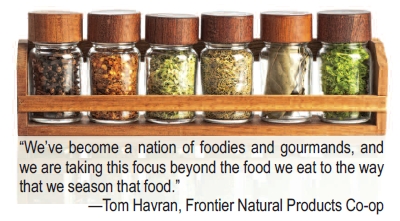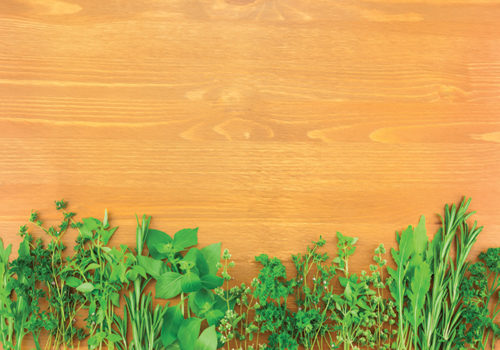Your mission: Make a 30-minute meal from scratch that’s flavorful, unique and cost-effective without piling on unhealthy fats, sweeteners or too much sodium. Your secret weapon? Herbs and spices!
Whether it’s as common as cinnamon or as adventurous as garam masala, shoppers know that spices are the epicenter of healthy, great-tasting meals. According to data from market research firm Nielsen, the spices/seasoning extract category is one of the top-10 center-store food categories posting gains over the past year (1). Clearly, this market is as hot as chili peppers, so make sure your store is prepared to help shoppers spice it up.
In the Salt Box
One of the trendier ways to flavor dishes is with gourmet unrefined sea salts. Gourmet salts?, you might ask. What makes them different from table salt?
“All salt is not created equal,” says Charmane Skillen, founder of s.a.l.t. sisters, Goshen, IN. “The table salt that most of us grew up eating is processed; its minerals are extracted and sold off, it’s bleached (which can leave behind trace chemicals) and iodine is added along with an anti-caking powder.” Meanwhile, salt is made when ocean water (or sometimes spring and lake water) is collected and evaporated.
Unrefined options likely appeal to your clientele, thus making gourmet sea salt very attractive. “When salt is unrefined, its make-up is most like our body’s own composition. We process and metabolize it much more efficiently. Plus, all of those ‘good for you’ minerals are still present,” Skillen states.
Those “good for you minerals” include magnesium, calcium, potassium, bromide and more (2), which are often stripped away during the high-heat processing of table salt.
Of course, sea salt may not have as much iodine as iodized table salt, says Ladd Gorman, chemist, research and development at J.R. Watkins, Winona, MN. Since the early 1920s, iodine has been added to table salt to combat iodine deficiency, a cause of thyroid problems and other issues. Most Americans wouldn’t otherwise have much iodine in their diets, since it mainly comes from eating seafood.
For those who enjoy using unrefined sea salt, but want the iodine, Carla Delangre, vice president of Celtic Ocean International/Selina Naturally, Arden, NC, says her company has a seaweed seasoning that offers iodine and great flavor. “Celtic Sea Salt seaweed seasoning is so tasty and so full of nutritious ingredients that supply our much needed daily allowances of iodine,” she states.
For customers concerned about their sodium intake, let them know unrefined sea salt isn’t better than table salt for avoiding sodium. Says Skillen, “Both sea salt and table salt contain about 40% sodium. Sea salt has some health benefits, but won’t lower your sodium intake one bit.”
So, what kinds of flavorful, gourmet sea salts are available? Skillen organizes the many varieties into three broad categories:
• Classic sea salt and mineral salt like mineral-rich Himalayan Pink.
• Smoked salts, which are often tan or brown, and add depth to savory foods. You’ll find salt distributors with varieties like hickory, alderwood and applewood smoked.
• Flavored salts, which are unrefined sea salts that have been “fused” with natural flavors like lime, garlic or truffle.
Within these categories are several textures like coarse crystals, fine crystals and flakes, which dissolve quickly.
Depending on one’s palate, recipe and salt variety, shoppers may see some differences between sea salt and table salt. Gorman believes some gourmet salts work best as a finishing agent to add something special to a prepared dish. “You’re more likely to notice a difference if they were used as a salty topping on a sweet dessert or tasted alone, side by side,” he states.
Meanwhile, Brett Cramer, founder of The Spice Lab, Pompano Beach, FL, makes the point that sea salts are smoother tasting, since “iodized salts are often bitter because of the anti-caking agents added.”
In agreement is Tom Havran, communicator of natural living at Frontier Natural Products Co-op, who adds that the refined sodium chloride in iodized table salt has an overpowering, harsh alkaline flavor. “It’s a fine starting material for compounding with spices and flavorings to build seasonings, or for use in baking where consistently measurable accuracy is needed, but the one-note flavor of sodium chloride does not serve well for adding complex savor to food,” he believes.
 In these cases, Havran says, “you should turn to the gourmet flavors of French grey, fleur de sel and mined fossil sea salts to add minerals and flavor nuances to food. A simple vinaigrette dressing that is prepared with the briny sweetness of French fleur de sel will taste remarkable compared to one that is prepared with plain table or kosher salt.”
In these cases, Havran says, “you should turn to the gourmet flavors of French grey, fleur de sel and mined fossil sea salts to add minerals and flavor nuances to food. A simple vinaigrette dressing that is prepared with the briny sweetness of French fleur de sel will taste remarkable compared to one that is prepared with plain table or kosher salt.”
“Different salts can really add ‘personality’ as well as unique taste to dishes—all while delivering minerals the body needs,” agrees Kori Rodley, public relations and media coordinator, Mountain Rose Herbs, Eugene, OR. She notes that her company’s Black Lava Salt has a distinctly different taste than, say, its Red Alaea Salt. “The Black Lava Salt actually has naturally occurring activated charcoal and a higher mineral content—for those folks who need that in their diet, this can be a delicious way to go,” she states.
Cramer says salt tastes and textures vary by the region from where they are derived. “Different water and conditions create an amazing array of flavorful and unique salts from around the world,” he says. For instance, Cramer explains that Hawaiian Black Lava Salt has a high mineral content (7.28% minerals and electrolytes and 92.72% sodium), and “its slightly smoky taste and distinct flavor profile enhance any dish.”
Meanwhile, Cramer says, “Pink Himalayan salt is hand-mined from salt beds formed in the Jurassic era, more than 250,000,000 years ago.” Pink Himalayan salt from the Salt Mountains in Pakistan has 84 natural minerals in the untouched natural salt and is pink because of its high iron content. His company only selects dark pink crystals, which have the most nutrients and minerals.
In the end, retailers may want to be strategic in this category by offering shoppers some new and interesting choices that marry well with their store’s standards. Says Rodley, “There is definitely an awareness and interest in trying different salts, as well as increased customer knowledge around why organic and fair trade herbs, salts and spices are good choices.”
Red Hot Spices
There is much innovation happening right now in the area of seasonings. For starters, home chefs like the convenience of spice blends and, not surprisingly, are being drawn to spice/sea salt blends. Cramer says the traditional French blend of Herbs de Provence was always popular, and now the company has an Herbs de Provence and Sea Salt Blend. The firm also introduced Mediterranean Sea Salt & Spicy Pepper Blend and Mediterranean Sea Salt & Spice Medley.
Building on the smoked salts trend previously noted, Skillen says barbecue flavors with a global twist are much sought-after for great flavor in the rubs category. She has seen many combinations such as ginger with coconut or vanilla with butter. “Barbecue rubs are great for adding an instant kick to any dish,” she says.
While blends are of interest to many shoppers, Havran makes the point that other shoppers prefer the more hands-on approach of using “whole, unprocessed and unblended spices that are prepared fresh at home” and “do-it-yourself home-compounded seasoning blends.”
Havran adds that shoppers are also into pre-flavoring kitchen staples (like herb-infused butter and oils) and pre-treating whole spices by “dry pan roasting, oil frying, fresh grinding and blending.”
Moving away from salts and blends, Cramer also says “hot” is very hot right now. “By customer request, we now make a XXX Ghost Pepper Sea Salt that is three times as hot as our original blend of ghost pepper powder and sea salt,” he states.
Possibly one of the biggest drivers of growth are international flavors, especially Indian and Thai spice blends or curries, says J.R. Rigley, president and CMO of J.R. Watkins. He adds that Vietnamese flavors are also trending because, like Thai, they satisfy shoppers’ cravings for multidimensional flavors (combining sweet, savory and salty).
Havran also makes note of a trend you’ve likely seen in your store: “Along with this, consumers are showing greater interest in spice origins, both where they’re sourced and the history of the spice.”
Handle with Care
Just as shoppers want to know about spice origins, “there is a growing understanding that properly handled, fine-quality spices and seasonings are as important as the sourcing, quality and freshness of the main ingredients we consume,” Havran states.
Shoppers may want to know how to ensure the spices at home last as long as possible (and this information can make a great handout, too).
Cramer states that consumers should be in tune with a spice’s color and fragrance to help determine if it’s fresh. “Spices don’t go bad, but they do lose their potency,” he explains. “If fragrance is missing or the color has changed, it is time to replace your spices.”
Though freezing them probably isn’t a good idea, Delangre says refrigeration can help certain spices retain freshness. “After around four to six months, you may start to not taste the freshness as much,” she states. Skillen also suggests shoppers abide by the “six-month rule” when it comes to discarding most spices, though some items like those in the red pepper family (including paprika) can last longer.
Skillen says keeping spices in their original or a similar airtight container can help maintain color and taste. “What is important is that they are tightly re-sealed immediately after each use,” Skillen states.
Adding to this, Gorman suggests keeping them in a dark, cool, dry cabinet. “Be sure it’s not too close to a window with direct sunlight, the stove or dishwasher—heat and humidity can degrade the quality,” Gorman states. And, don’t pour spices from their containers over steaming pots and pans since the humidity can degrade the product.
Tips for the Small Retailer
Stores with a compact footprint don’t have to feel they are too small to carry the hundreds of herbs and salts that are available. “Stock your retail space the same way that a knowledgeable cook would stock their spice rack at home,” Havran suggests. “Smaller amounts, stored properly and refreshed often.”
He suggests 15 ”must stock” items: cumin seed, coriander seed, ginger, black pepper, vanilla, cayenne chili, oregano, thyme, clove, nutmeg, allspice, cardamom, turmeric, bay leaf and sage.
In addition, have good-quality natural sea salt on hand. Cramer recommends four types: 1) pink Himalayan sea salt in coarse and fine, 2) Hawaiian salt like black lava and red alaea, 3) smoked salt and 4) something hot like ghost pepper or habanero pepper salt.
If space allows, Rodley adds some extras that go beyond the basics like Herbs de Provence, a good curry blend, Chinese five-spice blend, a veggie mix and grilling herbs.
Additional spices from Rigley include cinnamon, rosemary, dill, ginger and smoked paprika.
In the aisles, train staff to be helpful to shoppers that want to experiment with new seasonings, but aren’t sure how or whether the price is worth it for an unknown taste.
Perhaps, start a recipe inspiration bulletin board on an empty wall that shoppers can add to. Social media sites (especially Facebook and Pinterest) are also great ways to share recipes with new spices and mouthwatering photos of items your staff made. “Providing recipes is a great way to guide customers in their experimentations,” Rodley advises. “Let people know what works well with what types of food.”
Cramer suggests the idea of a sampling day or tasting party to expose shoppers to new tastes. “Choose five or six different salts with various textures, colors and regions,” he suggests. “Serve the salt selection with a wide array of fresh vegetables and fruits, mild cheeses and bread.”
Stores may also want to consider going both big and small. According to Havran, “Consumer uncertainty is one of the many reasons a bulk section can be a major asset to any store. With bulk spices, shoppers can ‘buy a pinch or a pound’ in order to experiment or buy just the right amount needed for a recipe.”
Another option is to stock mini-packaged spices to “give shoppers a quick and easy way to purchase a smaller amount,” says Havran. WF
References
1. “Spices at Hug of Positive Trends,” Facts, Figures & the Future, June 2013, www.factsfiguresfuture.com/issues/june-2013/spices-at-hub-of-positive-trends.html, accessed Nov. 22, 2013.
2. D. Norek, “Choose Unrefined Sea Salt over Table Salt ,” Natural News, July 16, 2010, www.naturalnews.com/029212_sea_salt_sodium.html#ixzz2lgV0hxiQ, accessed 11/25/13.
Published in WholeFoods Magazine, January 2014










